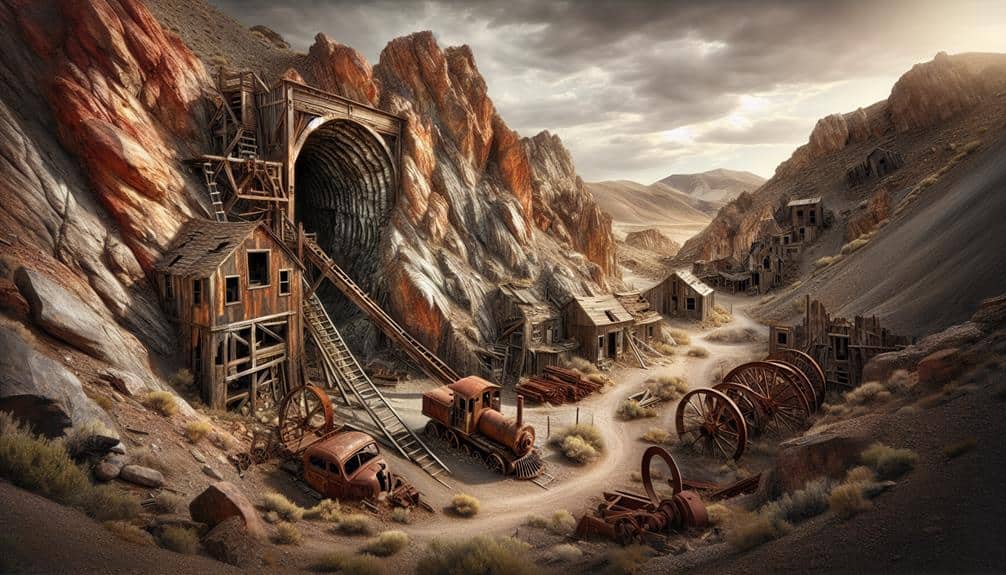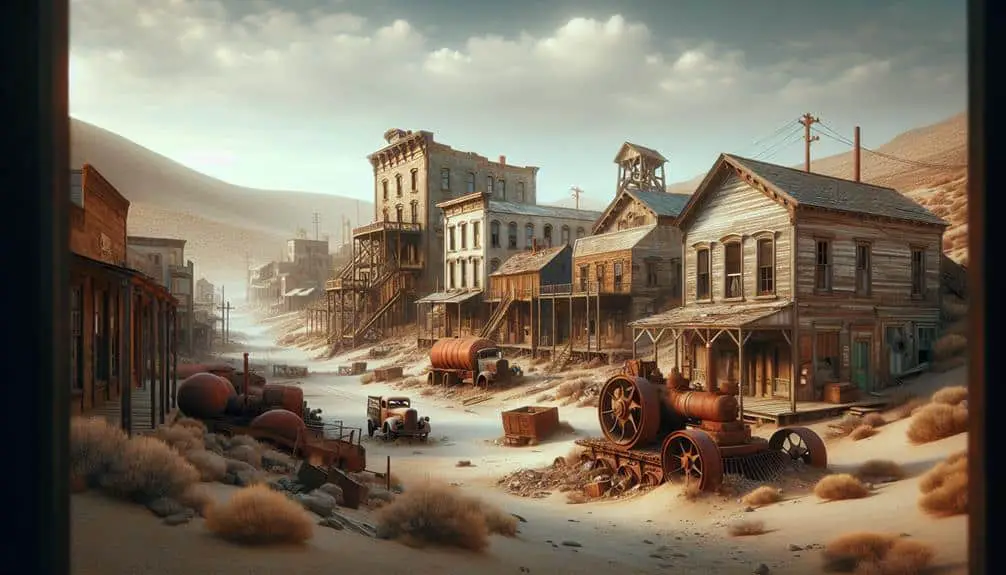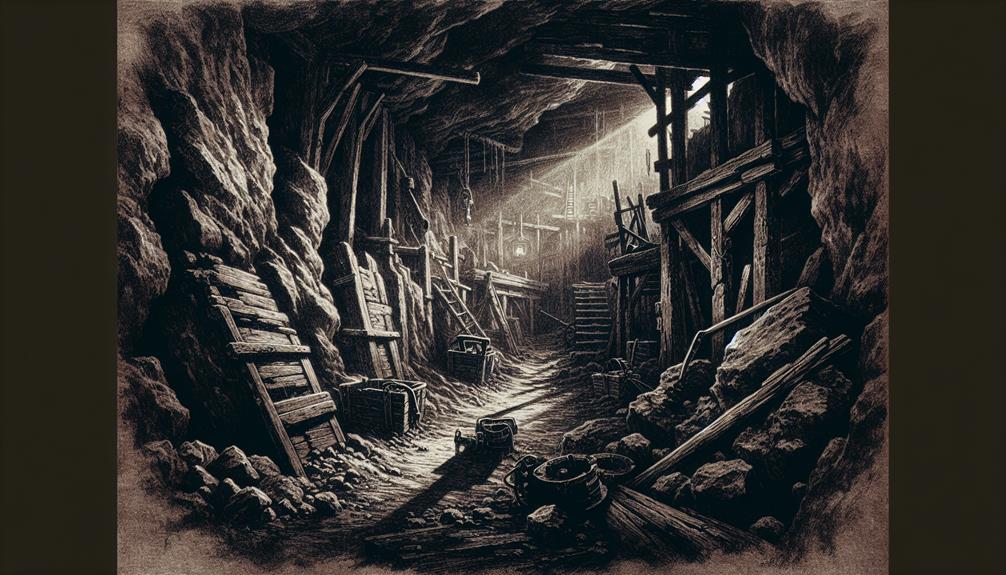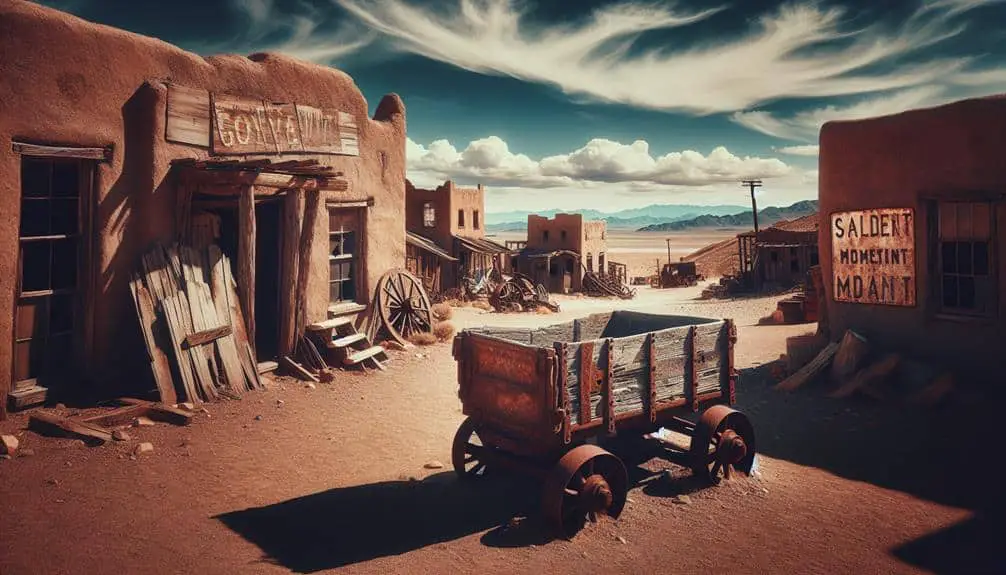Uncover the fascinating history of silver mining in Nevada's ghost towns. Unearthed in the mid-19th century, silver sparked a rush for wealth. From placer to hydraulic mining, technologies evolved for ore extraction. Booming towns saw population surges and advancements in silver extraction. Miners faced harsh conditions, safety risks, and health hazards in pursuit of riches. Market fluctuations, labor shortages, and environmental impacts led to the industry's decline. Today, Nevada's ghost towns stand as witnesses to a prosperous past, offering cultural preservation and tourism potential. Explore the intriguing journey of these once-thriving communities.
Key Points
- Silver discovery in mid-19th century sparked mining rush in Nevada.
- Boom of silver mining towns due to population influx and technological advancements.
- Miners faced harsh conditions, safety risks, and health hazards for wealth.
- Decline in silver industry due to market fluctuations and environmental impact.
- Legacy of Nevada ghost towns as cultural heritage and tourist attractions.
Silver Discovery in Nevada
Silver was first unearthed in Nevada in the mid-19th century, igniting a rush of miners to the area in search of wealth. This influential discovery led to the development and implementation of various mining techniques in the pursuit of silver. Miners utilized traditional methods such as placer mining, where they'd pan for silver in river beds and streams, as well as hard rock mining, which involved excavating silver ore from deep underground.
The discovery of silver in Nevada prompted miners to employ more advanced techniques as technology progressed. Hydraulic mining became prevalent, allowing miners to use high-pressure water jets to dislodge and transport silver-bearing ores for processing. This method greatly increased the efficiency of extracting silver from the earth. Additionally, the introduction of stamp mills revolutionized silver mining by crushing the ore into fine particles for extraction.
Boom of Silver Mining Towns
During the boom of silver mining towns in Nevada, a rapid influx of settlers transformed the once desolate landscapes into bustling communities centered around the lucrative silver industry. Economic growth surged as these towns sprang up, attracting people from far and wide seeking their fortunes in silver mining. The development of innovative mining techniques revolutionized the efficiency of extracting silver from the rich veins within the Nevada mountains.
Here are some key points about the boom of silver mining towns:
- Population explosion led to the rapid expansion of towns.
- Increased demand for goods and services fueled local economies.
- Technological advancements improved silver extraction processes.
- Miners from diverse backgrounds contributed to the vibrant community.
- The rise of infrastructure to support the growing population showcased the towns' prosperity.
The convergence of opportunity and resources in these silver mining towns epitomized the American spirit of entrepreneurship and exploration during this era of rapid industrialization.
Challenges Faced by Miners
Facing a myriad of obstacles, miners in Nevada's silver mining towns encountered significant challenges in their daily pursuit of extracting precious ore from the rugged terrain. The working conditions in the mines were harsh and demanding, with miners often laboring long hours in cramped and poorly ventilated spaces deep underground. These conditions not only took a toll on their physical health but also posed serious safety risks. Cave-ins, explosions, and toxic gas exposure were constant threats that miners had to navigate while endeavoring to meet production quotas.
Moreover, the nature of the mining work itself exposed miners to various health hazards. Dust inhalation containing harmful particles like silica led to respiratory issues such as silicosis, while accidents with heavy machinery resulted in injuries ranging from minor cuts to fatal incidents. Despite these challenges, miners persevered, driven by the promise of striking it rich in the silver mines of Nevada.
Decline of Silver Industry
Struggling with plummeting ore prices and rising operational costs, the silver industry in Nevada's mining towns saw a gradual decline in profitability during the late 19th century. This decline had significant economic repercussions on the region. Here's a closer look at the factors contributing to the downfall of the silver industry:
- Market Fluctuations: The unpredictable nature of silver prices made it challenging for mining companies to forecast revenues accurately.
- Labor Shortages: The boom in mining activities led to labor shortages, impacting production levels and increasing operational costs.
- Technological Limitations: Outdated mining techniques hindered efficiency and profitability in an evolving industry.
- Environmental Impact: Mining operations in Nevada's ghost towns left a lasting environmental impact, contributing to land degradation and pollution.
- Competitive Pressures: The emergence of new mining regions with lower production costs intensified competition, further squeezing profit margins.
Legacy of Nevada Ghost Towns
The enduring remnants of Nevada's ghost towns bear witness to a bygone era of silver mining prosperity and the subsequent decline that shaped their legacy. These towns, once bustling with activity, now stand as poignant reminders of the boom and bust cycles that characterized the silver mining industry in the region. The cultural preservation of these ghost towns has become a priority for many, as they offer a glimpse into the past and provide valuable insights into the history of the American West.
Despite their desolate appearance, Nevada's ghost towns hold immense tourism potential. Visitors are drawn to these abandoned settlements, intrigued by the stories of the people who once called them home. The unique blend of history, mystery, and nostalgia that surrounds these towns makes them popular destinations for explorers and history enthusiasts alike. By promoting the cultural significance of these ghost towns, Nevada has the opportunity to attract more tourists and generate interest in its rich mining heritage.
Frequently Asked Questions
What Were the Specific Environmental Impacts Caused by Silver Mining in Nevada Ghost Towns?
When silver mining in Nevada ghost towns, the environmental impacts were significant. The mining operations led to environmental degradation, such as deforestation and water pollution. Residents also suffered health impacts from exposure to toxic chemicals.
How Did the Silver Industry in Nevada Ghost Towns Impact the Local Native American Populations?
The silver industry in Nevada ghost towns greatly impacted local Native American populations. Their culture faced erosion due to economic displacement caused by mining activities. This led to profound changes in traditional ways of life and societal structures.
What Role Did Women Play in the Silver Mining Industry in Nevada Ghost Towns?
In Nevada ghost towns, women played vital roles in the silver mining industry, often facing challenges in labor rights. Despite this, they comprised 17% of the mining workforce, contributing immensely to the industry's success.
Did Any Notable Celebrities or Historical Figures Visit or Have Connections to Nevada Ghost Towns During the Silver Mining Era?
Famous visitors added allure to Nevada ghost towns during the silver mining era. Historical connections deepened as notable figures explored these rugged landscapes. Their presence left lasting imprints on the rich tapestry of the region's history.
What Are Some Lesser-Known Ghost Towns in Nevada That Were Once Thriving Silver Mining Communities?
When exploring Nevada's lesser-known ghost towns, you'll uncover hidden gems like Belmont and Tybo, once vibrant silver mining hubs. Discover unique mining techniques used in these communities and ongoing preservation efforts to safeguard their economic decline and cultural significance.



